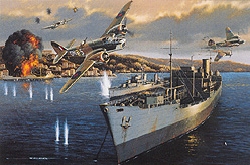|
|
| Dangerous Duty |
|
 |

|
 |
|
|
| DESCRIPTION |
 |
| 16 x 11.5 Inch Collector Size Unframed Lithograph $40.00
Some of those most dangerous missions of WW II were the low level shipping attacks by Bristol Blenheims carried out against Axis shipping. These missions were important in the early stages of the War in the Mediterranean in terms of disrupting supply lines to Rommel's troops fighting in North Africa. It was not uncommon for the RAF to lose 10-30% of the aircraft it sent on such missions. One of the most successful of the RAF's Blenheim pilots was Sir Ivor Broom, who rose from the rank of Sergeant Pilot, completing three combat tours, including thirty-one low level attacks while based on the island of Malta. With all the officer pilots in his squadron either killed or missing in action, Broom received his commission. Allied interdiction efforts had become so successful that in October and November of 1941 only 25% of the supplies destined to supply Rommel's armies in North Africa were getting through. The Germans decided to reroute their supply ships, opting for taking a longer route, but one which made Allied attacks much less likely. The Blenheims's of Broom's 107 Squadron had sufficient range to reach shipping targets off the Greek coast, but this necessitated a long over water flight and precise navigation. Broom's 43th combat mission involved the attack on German ships at anchor in the harbor at Argostoli which was on the island of Cephalonia off the west coast of Greece. The ships there were forming a convoy which would make the dash to Benghazi. Six Blenheims from 107 and 18 Squadrons took part in the raid. With Broom in the lead the six attackers avoided the heavily armed coastal defenses by approaching the harbor from an inland direction. This required some highly skilled low level flying as they followed a road through a saddle in the hills. With the advantage of surprise on their side the six attackers swept down on the ships at anchor in the harbor at mast height. After releasing their bomb load the group executed a sharp turn to starboard and a fast climb up and over the hills to the west of the harbor. A-A fire greeted the Blenheims as they made their escape, and two of the six aircraft fell victim. This attack on December 13, 1941 is depicted in Stan Stokes painting appropriately entitled Dangerous Duty. The Bristol Blenheim, the most plentiful aircraft in the RAF's inventory when WW II began, was designed by Frank Barnwell, and when first flown in 1936 was unique with its all metal monoplane design incorporating a retractable undercarriage, wing flaps, metal props, and supercharged engines. A typical bomb load for a Blenheim was 1,000 pounds. In the early stages of the war Blenheims were used on many daylight bombing missions. While great heroism was displayed by the air crews, tremendous losses were sustained during these missions. The Blenhiem was easy pickings at altitude for German Bf-109 fighters who quickly learned to attack from below. To protect the vulnerable bellies of the Blenheims many missions were shifted to low altitude, but this increased the aircraft's exposure to anti-aircraft fire. |
|


|